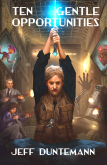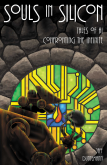- Have been reading copyedits and catching up on any number of things after five weeks away from home. We’re going to have real books out of the bindery on or about October 1. For the time being, I’ll be glad to just Not Be Doing Book anymore. (And that should be on or about June 30.)
- Some twit (maybe twits) wrote Twitter apps that store unique tweet ID numbers in signed 32-bit integers. The tweet count since startup is approaching the magic number 2,147,483,647. After that, tweet IDs become negative, and hilarity reliably ensues. Should be tomorrow; let’s watch.
- In other recent software fails, Ubuntu 9.04 broke Skype out here, and made sound support work a little weirdly generally. The Mute button gets checked all by itself for no apparent reason. This is evidently not a problem I’m having all by my lonesome, but time to fix it has been scarce.
- A 14-year-old boy got hit by a meteorite, albeit a smallish one. He got a 3-inch scar on the back of his hand, which (once the bandanges come off) will be the most interesting conversation piece he is ever likely to own, since he evidently had to give up the meteorite itself.
- Building this must have been a picnic. (But I’ll bet the view’s to die for.) It’s a tourist thing, like the tchochke shop atop Pike’s Peak, but way cooler. And yet another reason I have to get back to France someday.
- If everything goes well and the IC-729 still works, I may be out in the (pacified) woods somewhere working Field Day on June 27-28. (I hate to haul my IC-736 into the wilds, but I will if I have to.) I have an RV with a generator, an AH-3 antenna tuner, and an obscene amount of wire. I know I can’t use an RV park’s electricity, but can I use their water pipes for an RF ground?
software
Odd Lots
Jaunty Jackalope in Only 2:45
I finished and packed off the introduction to the book today, which doesn’t leave a great deal more to do. I’m still “discussing” how to handle my two ASCII charts, which I laid out in InDesign and exported as PDFs. It boggles to imagine that nobody there knows how to insert a PDF into a print image, but that’s the impression I’m getting. Now and then I think publishing was better off when we strung books together with X-Acto knives and waxers.
Let it go, I keep telling myself. Nobody’s going to hang me if I don’t include a concise representation of the IBM-850 code page, as useful as it might sometimes be.
And my do-it list is calling to me. I knocked off an item today that’s worth relating: I upgraded the Ubuntu 8.10 instance on this machine to 9.04. I let the updater do it, just to see how automatically and how accurately it would happen. I’ve got a lot of software installed there (including several Windows apps under Crossover) and lots of configuration tweaks.
It happened completely automatically. I was asked twice if I wanted to keep the existing menu.lst file, which I didn’t recognize and didn’t run downstairs to look up. Alas, I told it to keep the existing one, which it obediently did–and thus didn’t update the menu display for Grub. I can fix that, but I’m annoyed at myself for being too lazy to look first.
Beyond that, as best I can tell, nothing was corrupted or left out or changed in any significant way. It took two hours and forty-five minutes, most of which was spent downloading 1,413 files from the repositories. It didn’t demand to reboot until the end of the process, which is a trick Microsoft should learn.
I admit, I was a little disappointed that there’s no funny animal in the default wallpaper. I liked the Hardy Heron art a lot; and Intrepid Ibex wasn’t bad once I got used to it, as much as it resembled a soda glass ring on a leather couch. Jackalopes don’t exist except in our imaginations (though there was one on the wall of the Pie Pan restaurant in Sauganash where we lunched with my grandmother in the early 1960s) so perhaps omitting it makes a rough kind of sense. Come October we’ll see what a Karmic Koala looks like. Maybe.
Anyway. It went great. Completely trouble-free so far. Highly recommended.
Odd Lots
- The Atlantic tells us that a growth industry in NYC and other crowded cities is training dogs to sniff out…bedbugs. Dogs who can tell live bedbugs from dead earn as much as $325 an hour, and work for kibble. I got some peculiar bites on one side of my right leg while we were down in Champaign-Urbana last week for Matt’s graduation, and while I can’t prove that bedbugs did it, that side of my right leg is the side that contacts the bed while I sleep (as I nearly always do) on my right side.
- From Chris Gerrib comes word that The Espresso Book Machine has finally been installed in a bookstore, where it prints from a selection of half a million books on the attached server. No word on whether these are all out-of-copyright titles or what, but after what seems like decades of screwing around (I first reported on the Espresso Book Machine, originally called the PerfectBook 080, in 2001) we’re finally getting somewhere.
- I’ve heard tell recently that Vista doesn’t play nice with the Xen hypervisor. Anybody had any crisp experience there?
- William Banting’s Letter on Corpulence is now available from the Internet Archive, and it’s interesting as the very first detailed description of the effects of low-carb diets. Way back in 1864 Banting lost weight by eating protein and fat, and seemed surprised enough by his results to write up his experiences in detail. The more I research this, the more I’m convinced that carbs are what’s killing us, and this is not new news.
- Lulu recently cut some kind of deal with Amazon to put all their books (I think; it certainly includes all of mine) in the Amazon database. However, they added five or six bucks to the cover price. Will people buy Carl & Jerry books for $21? Don’t know, but somehow I doubt it.
- Machines can often see things that we can’t (which is one reason that we build machines) and they’re willing to share what they see with us. Sure don’t look like this in an 8″…
- Ars Technica published a good article on how DRM actually makes the piracy problem worse–an insight I had years ago, and a painfully obvious one after thinking about it for a nanosecond or two.
- No rest for the weary; several people wrote to ask what I would be writing next. Not sure. I still have to get our butts back to Colorado, but once I do, I want to finish my second SF story collection, and work on Old Catholics. You can bet that I’ll be posting more on Contra too, if that counts. Further than that I won’t venture, though I think I’ll be leaving computers alone for a little while.
Odd Lots
- Still sniffling, still congested, still coughing, and still mostly lying on my back, taking a Zicam every three hours like clockwork. I feel better generally, but the growing pile of Kleenex on the floor next to the bed provides time-trend rather than anecdotal data. This has been worse and tougher to shake than I had hoped.
- The Cassini Saturn probe can actually watch ring disturbances occur, especially those caused by the way-far-in moon Prometheus. Here’s the culprit making tracks in the ring system, courtesy Astronomy Picture of the Day.
- There is a portable version of Scribus, the only open-source desktop publishing system that I respect. One key principle of degunking Windows PCs is to staythehell away from the Windows Registry, and portable apps, almost by definition, leave no fingerprints there. There’s more here than most people understand, and Wikipedia’s list of portable apps is a very good place to start. (I advise reading the entry talk page.) Here’s another big list.
- Another key principle is to avoid software that insists on launching services all the time, having tray icons, etc. Most of these are commercial packages that are desperately trying to upsell you. Best path here is to avoid commercial software as much as possible, especially trialware and “basic” versions that are invitations to install nagware and are often very hard to get rid of.
- (Next morning.) The nose is drying out (finally) but the cough is still with me. About to head out for some yummy McDonald’s iced coffee, with sugar-free vanilla flavoring, to chase a delectable Sausage McMuffin with Egg. I’m stuffing my pocketses with Kleenex, but after two days of self-enforced isolation, it’s almost within my grasp: The Contrarian Breakfast of Champions!
- (Later.) It’s been a bad season for the Global Warming crowd. Freeman Dyson jumped the Tiber, and now says that the whole thing is a religion. The Australian Bureau of Meteorology has admitted under duress that its Antarctic bases have shown a cooling trend since 1980. Another Australian, albeit a hated Tory, penned a pretty good summary of the problems to be found when you study the data and not the dogma. Word seems to be getting out: Only 30% of Americans support cap-and-trade, which has become corrupt even before becoming law. And here’s what one of the sponsors of the Waxman-Markey bill has to say about the dangers of global warming. OMG, if that tundra at the North Pole ever emerges from under the ice, we’re all gonna die!
- Remember Global Cooling? I lived through it. It was scary. The lesson? We knew shit about how climate worked in 1975. And today? We know shit plus 15%. Some humility (and caution) are called for.
- (Still later.) Gosh. I really must be feeling better. The needle has climbed out of “groggy” and is rising rapidly through “puckish” on its way back to “jovial and unprovocative.” Dare I hope to get all the way to “serene”? Not likely; the viruses are surrendering, but I still have 35,000 words to go on the book–and I can’t find any Diet Green River!
Odd Lots
- SRWare Iron was doing a peculiar thing: When I used it to view my junkbox.com main page, the title image was broken. This was not the case using IE, FF, or Opera. Nor was it true of the several other images on that same page, but only that big main one. An intuition led me to look up the name of the image file: junkboxmainbanner.png. I renamed the file “junkboxmain.png” (that is, removing the substring “banner” from the filename) and the image began rendering normally. I guess there’s a downside to adblockers as twitchy as this one.
- From Bruce Baker comes a nice chronological screenshot survey of computer GUIs since the primordial Xerox Alto in 1973, up through Windows Vista and KDE 4. No judgements are passed on the products, and not much history is offered, but it’s unusual to see them all lined up in one place, and one definitely gets a sense for the way it all evolved, and especially for the immeasurable debt that Apple owes Xerox.
- On a tip from Pete Albrecht, I’ve learned that the Progressive Insurance girl Flo and one of the Geico cavemen shared a scene in the short-lived 2007 TV sitcom Cavemen . Here’s a YouTube clip of the scene. This was sheer coincidence; the Progressive ad campaign did not happen for at least a year after that and Stephanie Courtney just happened to get the part. I tried to like the series and failed, but I’ll admit that it had some surreal moments, a few of which we evidently didn’t appreciate at the time. Now, cavemen ate geckos. (Cavemen ate anything they could catch.) Dare we hope…
- Here’s an old article from Popular Mechanics on building your own Geiger counter. Michael Covington reminds me that there was a circuit in Alfred Morgan’s book The Boys’ Second Book of Radio and Electronics, though it had a peculiar power supply and didn’t work when I tried to build it in 1966. (I may still have the G-M tube somewhere, but I can’t find it and in truth haven’t seen it in decades.)
- Yet another one, this time from Popular Science, March 1950.
- Todd Johnson suggests using scrounged or surplus fluorescent lamp supplies from computer scanners for homebrew Geiger counters. I’ve got two defunct scanners on the woodpile downstairs, but if you don’t, Todd also sent along a pointer to a surplus source, for only $5.
- Today is Ubuntu 9.04 day. It’s like the Day after Thanksgiving at Marshall Fields up there, so don’t expect much in the line of download performance. I’m going to wait for the dust to settle a little (and maybe for my assembly book to be done) but it will happen here sooner or later. If you want it, look for torrents. And come with a backpack of patience.
- Do you have Linux running on an Intel DQ35 motherboard. If so, be careful.
- Finally, this clever food hack reminds me vaguely of something. I don’t know what. That’s probably just as well.
Iron Filings
I’m a little disappointed in the new Chromium-based browser SRWare Iron (see my entry for April 18, 2009) or perhaps I should say a little disappointed in SRWare itself. The browser has worked extremely well the last couple of days here on my quad-core XP machine. After only a little sleuthing I made the ad blocker work: All you have to do is download a text list of ad sites into the Iron directory, and the browser runs with it. (The browser is shipped with an empty adblock.ini file.) However, Pete Albrecht alerted me to the fact that Iron won’t run at all on his Windows 2000 machine–even though SRWare hints that it might.
Google is quite firm about it: Chrome won’t even install under Win2K. XP and Vista are all you get. However, down in the German-language portion of the SRWare Web site, Pete (who is fluent in German and in fact translates engineering texts for a living) found this:
There is something new for users of Windows 2000 as well; for cost reasons, there are still many users of this system, for example, in business. While Chrome can’t even be installed on Windows 2000 systems, Iron has also removed the warning message that appears whenever it is started on a Windows 2000 system. However, installations under Windows 2000 remain unsupported, as there may be isolated problems.
(Pete’s translation; the item is not present in English.) Well, if the problems are isolated, they’re isolated in a peculiarly concentrated fashion. I loaded Iron Portable on a Cruzer Mini and woke up every operational Win2K machine I still have in the house. (This took some waking; my poor 2001 ThinkPad doesn’t work very well anymore.) Iron failed on all four machines, with variations on the following error message:
The procedure entry point <whatever> could not be located in the dynamic link library KERNEL32.DLL.
KERNEL32.DLL is one of several places where the fundamental Windows API lives. The API call that failed was not always the same, but in every single case, Iron failed to start.
0 for 5 on Win2K, sigh. Iron won’t run on Linux or Mac either. (Nor will Chrome.) What bothers Pete and me is that SRWare suggests that the software should run under Win2K, with only “isolated problems.” Why not just be honest? If people get their hopes up that your software will run on their systems and then find out the hard way that it won’t, it only makes your software (and you) look bad. This is not the way to make a very promising software product catch on.
The Iron Sandbox
I’ve been pretty focused the last three or four months, so I mostly missed the whole discussion about Google Chrome and its pros and cons. Parts of Chrome are very impressive, particularly the “sandbox” security model–and parts are about what you’d expect from a monster company that makes its money on Web ads. I caught snatches of the debate here and there, but it wasn’t until I found myself at 3 PM today with 5,100 words’ worth of progress made since 7:30 AM that I decided, enough of this. (I’m now 133,000 words in and pretty much on schedule again, having lost some ground in March.) So I kicked back and started reading up on Chrome. In doing so, I found something I hadn’t expected, or heard about at all: SRWare Iron.
What Iron looks like to me is Chrome with Google’s business model stripped out. Chrome itself was based on a number of different technologies, most of them open-source, including Google Code’s Chromium browser framework and the WebKit rendering engine. Google built a number of tracking mechanisms into Chrome, including a unique user ID and a few other mechanisms for sending search statistics back to Google. These seemed relatively benign to me (perhaps I’ve seen too much of the really bad stuff, heh) but a lot of people got very upset over the Chrome privacy model.
Enter SRWare, a German software security firm. They took the open-source codebase for Chrome and stripped out whatever they considered dicey from a privacy standpoint. They updated the WebKit rendering engine, did a few other miscellaneous security tweaks, and re-released the product as Iron. This sounds presumptuous to some people, but that’s how open source works. (There’s nothing preventing Google from re-absorbing SRWare’s changes, but as the changes are mostly features removed, that wouldn’t be especially useful.) Basically, we have a Chrome variant that doesn’t track your searches and phone home.
That’s good, and as browsers both Chrome and Iron have reviewed well. Chrome (and therefore Iron) do well on Web standards, passing Acid1 completely and Acid2 with only minor glitches. But what I find best about Chrome/Iron is the security model. Each tab is a separate process, and each tab process has its system rights severely restricted. Even if the browser itself is running in an admin account, the tabs run as restricted users, with a few further restrictions. Malware may well run in a tab, but there is very little that the malware can do except run in the tab. It can’t install software, sniff other processes, write files, or survive the closing of the tab. It’s not a per-tab virtual machine (which is where I think malware will eventually force Web browsers to go) but it’s a giant step in the right direction. (InfoWorld has a nice discussion of the Chrome security model.) I’m still having a little trouble getting a technical grip on the merits and flaws of Chrome’s V8 javascript virtual machine, but I’ll keep sniffing around and will eventually figure it out.
The security model prevents many plug-ins from working correctly, and this may bother some people more than others. Not me: Plug-ins are the 900-square-foot hole in browser security generally, and for basic Web research, I can do without, well, all of them.
I’ve only had a couple of hours to fool with Iron, and I’ll tell you right now that I like it a lot. I installed the portable version, which confines all of its files to a single directory and does not touch the Windows Registry. The rendering is very snappy, snappier than Firefox 3. (I haven’t touched IE in so long I didn’t even bother making a comparison.) It imported all my bookmarks without a burp, though it did not automatically place my Firefox toolbar bookmarks in its own toolbar. (I did that from Iron’s bookmark manager with one drag and drop.) I read somewhere that Iron had a built-in ad blocker, but I don’t see any controls for it, and I’m still seeing lots of ads.
Still, what attracted me to Iron is its approach to Web security…and over and above everything in the code, what may make Iron safest of all browsers is that it’s rare. Security exploits are often (if not always) app-specific or at least library-specific. Malware depends heavily on the density of the installed base to succeed, which is why so many exploits target IE, and more recently Firefox. As long as the software works well for me, I don’t care how few copies are out there–in truth, the fewer the better. SRWare has kept up with patches on both the Chrome code base and the WebKit code base (which Chrome itself hasn’t kept up with) and assuming they continue to do so, we may have us a breakthrough in the malware wars. It’s still early, but I’m already very impressed. (I’ll come back with “highly recommended” if I still think so in a few weeks. Stay tuned.)
Odd Lots
- The dairy that delivered milk to our house when I was a kid was indeed Hawthorn Mellody Farms (as verified by the Sister of Eidetic Recall) which was unusual in several ways: They had an amusement park in Libertyville, Illinois, complete with a miniature train ride, a petting zoo, Western town, and pony rides, that was a famous destination in the 50s for suburban moms with station wagons full of Boomer kids. They were the first dairy to put pictures of missing children on milk cartons. And before they went bankrupt in 1992, they were one of the largest Black-owned businesses in the country.
- Also relevant to my entry of Febraury 24, 2009: Dunteman’s Dairy evidently existed before 1939. A page out of the 1937 Arlington Heights phone book from Digital Past shows an entry for Dunteman’s Dairy at 830 N. Dunton Avenue in Arlington Heights. The 1936 phone book shows a listing at the same address for “L. Dunteman,” so Lenard may have begun operating the dairy from his back yard (not an uncommon thing to do back then!) in that year. Prior to 1936 his listing shows yet a different address. I’ll have to see what’s at that address today the next time I’m in the area.
- Digital Past is a very good source if you’re doing genealogy research on Chicago’s northwest suburbs; awhile back I found the location and a photo of the headstone of Laura Brommelkamp Dunteman there, after looking in vain for some years. (She was the second wife of Henry Dunteman, founder of R. W. Dunteman Construction, which is still in operation in Chicago’s western burbs.)
- Well, grub is still plug-ugly, but it’s no longer difficult to configure. I’ve been using KGrubEditor for over a month now, and it makes the job a breeze. Highly recommended.
- Where’s my flying car? Well, it may be here: Yet another Skycar concept, but this time it’s more Mad Max than Flash Gordon. Put a big fan on the back of a go-kart, get up some speed, and then release the parawing. Off you go!
- Philip Jose Farmer has left us. Along with Heinlein, Clarke, and Keith Laumer, Farmer was one of the SF writers who inspired me to keep going and make something of myself in fiction. I still consider the Riverworld concept one of the most compelling ideas ever to surface in SF, even though the series wandered toward the end and would have been much better had it been three books (on the outside, four) instead of five.
- I was going to do a whole entry on this, but Cory Doctorow said everything I intended to say about whackjob Roy Blount Jr and the knucklehead Authors’ Guild, who want money from anyone who does text-to-speech. There’s nothing I can add, and as a longtime author who still makes money writing, I think I have a right to strong opinions about this. Let me quote Cory here, and cheer:
-
Time and again, the Author’s Guild has shown itself to be the epitome of a venal special interest group, the kind of grasping, foolish posturers that make the public cynically assume that the profession it represents is a racket, not a trade. This is, after all, the same gang of weirdos who opposed the used book trade going online.
A Chart, If You Can Read It
The last couple of evenings I’ve been working at fulfilling a promise I reneged on ten years ago. Somewhere in the text of the second edition of Assembly Language Step By Step (which I was writing in the summer of 1999) I promised readers an ASCII chart as one of the appendices. I then plum forgot, and the book appeared in 2000 without that appendix. I still get emails from people asking me where they could find the chart, and have to reply in my best sheepish email voice that no chart exists anywhere in the book.
So this time I thought to put things right. I sat down in front of InDesign and figured out an ASCII chart format for the full 256-character extended set, and drew me an ASCII chart. For the encoding I used Code Page 437, which is what they now call the IBM PC ROM character set. Whether they could name it or not, CP437 was much beloved of DOS text-mode programmers, with all four card suits and more box-draw characters than anybody ever knew what to do with. The chart will fit comfortably (if snugly) on a single page in what we in publishing call “computer trim,” and I consider it a complete success, at least if you have good eyesight or a set of readers within easy reach.
Except…
As best I can tell, there is no encoding option available for Konsole (or any other Linux terminal emulator that I have) for Code Page 437. As close as I’ve come is IBM-850, which has fewer box-draw characters and more non-English alphabet glyphs. Of course, once you have a chart, it’s no big deal to find a new set of glyphs and sub them in, which is what I’ll be doing in coming days. In the meantime, if you have any use at all for a CP437 ASCII chart, here it is. I’ll post the one for IBM-850 when I finish it. Ten years late, I guess, but better late than never.
Debuggery
In parallel with editing and (increasingly) writing chapters, I’ve been interviewing tools to feature in later parts of the third edition of Assembly Language Step By Step. Kate has the gig for editor, but the debugger slot has been annoyingly open for a long time. Since the beginning of the year I’ve been interviewing debuggers and GUI debugger front-ends for gdb, which is more an engine than a debugger and may well be the single most painful piece of software I’ve ever had to use. (Don’t get me started on that. Whoops. Too late.)
It’s been frustration cubed. Here are some notes on the fray thus far:
- Nemiver does not work correctly with assembly language executables.
- Insight would be a good choice, but it is one of the ugliest things I’ve ever seen running on Linux, and I mean ugly in the sense of, well, ugly: Badly rendered Motif/Lesstif screens that seem scruffier than they should be, with hard-to-read tiny fonts. I know why they used that widget set (it’s very lightweight) but I also think that’s no longer anything like an issue in the Linux world.
- DDD is uglier than Insight, and doesn’t work as well.
- KDbg was my favorite for a long time, because it’s not ugly and fairly straightforward to use, but its help system is broke and I never figured out how to dump memory or display named data items from assembly. Like Nemiver, it was really created with C and C++ in mind. Like people tell me endlessly (and shut up, already!) “Nobody uses assembly anymore.” Heh.
As I race past 65,000 words and close in on the end of Chapter 6, I was forced yesterday to make an executive decision and call Insight the winner. Insight is interesting in a number of ways: It’s not a GUI front-end for gdb; it is gdb, and has knowledge of gdb’s deep internals in a way that a separate app simply can’t match. The GUI was written in Tcl/Tk, a language I learned and enjoyed almost fifteen years ago when I got Ousterhout’s book in for review at PC Techniques. One would think it would be no big deal to rewrite Insight for Gtk or Qt, but I don’t see the dust from any stampede.
So I got me an ugly debugger. That is (given my deadlines and the significant amount of money riding on the project) better than no debugger at all.











